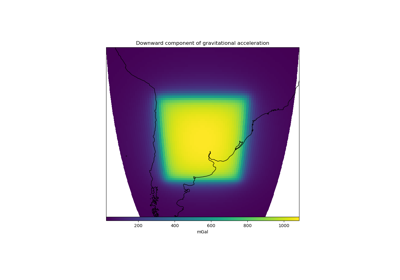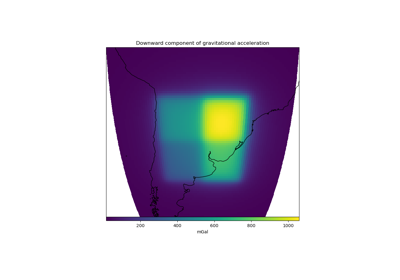harmonica.tesseroid_gravity
Contents
harmonica.tesseroid_gravity¶
- harmonica.tesseroid_gravity(coordinates, tesseroids, density, field, parallel=True, radial_adaptive_discretization=False, dtype=<class 'numpy.float64'>, disable_checks=False)[source]¶
Compute gravitational field of tesseroids on computation points.
Warning
The
g_zfield returns the downward component of the gravitational acceleration on the local North oriented coordinate system. It is equivalent to the opposite of the radial component, therefore it’s positive if the acceleration vector points inside the spheroid.- Parameters
coordinates (list or 1d-array) – List or array containing
longitude,latitudeandradiusof the computation points defined on a spherical geocentric coordinate system. Bothlongitudeandlatitudeshould be in degrees andradiusin meters.tesseroids (list or 1d-array) – List or array containing the coordinates of the tesseroid:
w,e,s,n,bottom,topunder a geocentric spherical coordinate system. The longitudinal and latitudinal boundaries should be in degrees, while the radial ones must be in meters.density (list, array or func decorated with
numba.jit) – List or array containing the density of each tesseroid in kg/m^3. Alternatively, it can be a continuous function within the boundaries of the tesseroids, in which case the variable density tesseroids method introduced in [Soler2019] will be used. Ifdensityis a function, it should be decorated withnumba.jit.field (str) –
Gravitational field that wants to be computed. The available fields are:
Gravitational potential:
potentialDownward acceleration:
g_z
parallel (bool (optional)) – If True the computations will run in parallel using Numba built-in parallelization. If False, the forward model will run on a single core. Might be useful to disable parallelization if the forward model is run by an already parallelized workflow. Default to True.
radial_adaptive_discretization (bool (optional)) – If
False, the adaptive discretization algorithm will split the tesseroid only on the horizontal direction. IfTrue, it will perform a three dimensional adaptive discretization, splitting the tesseroids on every direction. DefaultFalse.dtype (data-type (optional)) – Data type assigned to the resulting gravitational field. Default to
np.float64.disable_checks (bool (optional)) – Flag that controls whether to perform a sanity check on the model. Should be set to
Trueonly when it is certain that the input model is valid and it does not need to be checked. Default toFalse.
- Returns
result (array) – Gravitational field generated by the tesseroids on the computation points.
References
Examples
>>> # Get WGS84 ellipsoid from the Boule package >>> import boule >>> ellipsoid = boule.WGS84 >>> # Define tesseroid of 1km of thickness with top surface on the mean >>> # Earth radius >>> thickness = 1000 >>> top = ellipsoid.mean_radius >>> bottom = top - thickness >>> w, e, s, n = -1.0, 1.0, -1.0, 1.0 >>> tesseroid = [w, e, s, n, bottom, top] >>> # Set a density of 2670 kg/m^3 >>> density = 2670.0 >>> # Define computation point located on the top surface of the tesseroid >>> coordinates = [0, 0, ellipsoid.mean_radius] >>> # Compute radial component of the gravitational gradient in mGal >>> g_z = tesseroid_gravity(coordinates, tesseroid, density, field="g_z")
>>> # Define a linear density function for the same tesseroid. >>> # It should be decorated with numba.njit >>> from numba import jit >>> @jit ... def linear_density(radius): ... density_top = 2670. ... density_bottom = 3300. ... slope = (density_top - density_bottom) / (top - bottom) ... return slope * (radius - bottom) + density_bottom >>> # Compute the downward acceleration it generates >>> g_z = tesseroid_gravity( ... coordinates, tesseroid, linear_density, field="g_z" ... )


